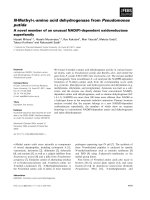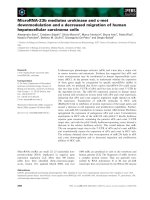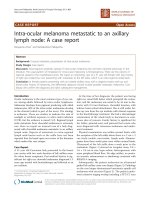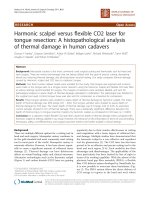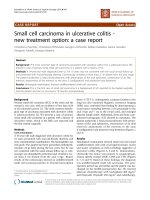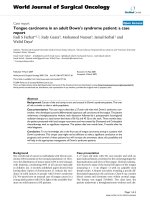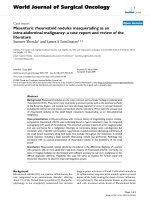Báo cáo khoa học: "Prolonged refractory status epilepticus following acute traumatic brain injury: a case report of excellent neurological recovery" docx
Bạn đang xem bản rút gọn của tài liệu. Xem và tải ngay bản đầy đủ của tài liệu tại đây (131.48 KB, 4 trang )
Open Access
Available online />R725
Vol 9 No 6
Research
Prolonged refractory status epilepticus following acute traumatic
brain injury: a case report of excellent neurological recovery
Adam D Peets
1
, Luc R Berthiaume
2
, Sean M Bagshaw
2
, Paolo Federico
3
, Christopher J Doig
4
and
David A Zygun
5
1
Research Fellow, Department of Critical Care, University of Calgary, Calgary, Alberta, Canada
2
Research Fellow, Departments of Critical Care Medicine and Community Health Sciences, University of Calgary, Calgary, Alberta, Canada
3
Assistant Professor, Department of Neurosciences, University of Calgary, Alberta, Calgary, Canada
4
Associate Professor, Departments of Critical Care Medicine and Community Health Sciences, University of Calgary, Calgary, Alberta, Canada
5
Assistant Professor, Departments of Critical Care Medicine, Clinical Neurosciences and Community Health Sciences, University of Calgary, Calgary,
Alberta, Canada
Corresponding author: David A Zygun,
Received: 31 Aug 2005 Accepted: 3 Oct 2005 Published: 27 Oct 2005
Critical Care 2005, 9:R725-R728 (DOI 10.1186/cc3884)
This article is online at: />© 2005 Peets et al.; licensee BioMed Central Ltd.
This is an open access article distributed under the terms of the Creative Commons Attribution License ( />),
which permits unrestricted use, distribution, and reproduction in any medium, provided the original work is properly cited.
Abstract
Introduction Refractory status epilepticus (RSE) secondary to
traumatic brain injury (TBI) may be under-recognized and is
associated with significant morbidity and mortality.
Methods This case report describes a 20 year old previously
healthy woman who suffered a severe TBI as a result of a motor
vehicle collision and subsequently developed RSE.
Pharmacological coma, physiological support and continuous
electroencephalography (cEEG) were undertaken.
Results Following 25 days of pharmacological coma,
electrographic and clinical seizures subsided and the patient
has made an excellent cognitive recovery.
Conclusion With early identification, aggressive physiological
support, appropriate monitoring, including cEEG, and an
adequate length of treatment, young trauma patients with no
previous seizure history and limited structural damage to the
brain can have excellent neurological recovery from prolonged
RSE.
Introduction
We describe a case of refractory status epilepticus (RSE) sec-
ondary to traumatic brain injury (TBI) requiring 25 days of phar-
macological coma with subsequent excellent neurological
recovery. A review of the relevant literature on RSE, including
diagnostic and treatment issues as well as the difficult ethical
questions surrounding appropriate length of treatment in this
condition, is undertaken.
Materials and methods
Case report
A previously healthy right-handed 20 year old woman sus-
tained multiple injuries following a rollover motor vehicle colli-
sion. Her initial Glasgow Coma Scale (GCS) was 6, but
deteriorated to 3 on scene. Her vehicle was found overturned.
She was belted into the driver's seat with the shoulder belt
compressing her neck. Her face was cyanotic. She was intu-
bated on scene and transferred to hospital.
In the emergency department, her temperature was 35.7°C,
blood pressure 112/66, heart rate 108 and oxygen saturation
on 50% FiO
2
was 98%. Pupils were 3 mm equal and reactive.
Minimal withdrawal to pain in the lower extremities was noted.
Reflexes were 1+ and symmetric with equivocal plantar
responses.
Initial laboratory investigations were normal. Injuries identified
included a burst fracture of the 6
th
and 7
th
cervical vertebral
bodies with canal narrowing of 50%, subluxation of the right
3
rd
cervical facet joint, and a right occipital condyle fracture. A
computed tomography (CT) scan of the head demonstrated a
hypodensity in the left cerebellum. CT angiography revealed a
cEEG = continuous electroencephalography; CT = computed tomography; GCS = Glasgow Coma Scale; MRI = magnetic resonance imaging; RSE
= refractory status epilepticus; SE = status epilepticus; TBI = traumatic brain injury.
Critical Care Vol 9 No 6 Peets et al.
R726
dissection at C3 and complete occlusion at C7 of the right
vertebral artery.
Six hours after admission, the patient had a witnessed gener-
alized tonic-clonic seizure that responded to 2 mg of IV
lorazepam. A 20 mg/kg IV loading dose of phenytoin was then
given followed by a maintenance dose of 100 mg IV q8h. Two
hours later, she was taken for decompression and fixation of
C6 to T1. Twelve hours post-operatively, generalized tonic-
clonic seizure activity was again noted, but resolved after 6 mg
of IV lorazepam. One hour later, further generalized seizure
activity did not respond to 8 mg of IV lorazepam, so three 100
mg boluses of intravenous propofol followed by an infusion at
50 µg/kg/minute was undertaken with clinical resolution of the
seizures.
A repeat CT head confirmed an evolving left cerebellar infarct,
but was otherwise unchanged. Continuous electroencepha-
lography (cEEG) was initiated, which demonstrated ongoing
and repeated right frontal electrographic seizures with sec-
ondary generalization. These were transiently suppressed with
further bolus doses of 100 mg of propofol, but would recur
despite increasing the infusion of propofol to 80 µg/kg/minute.
Therefore, a loading dose of 700 mg of pentobarbital was
given followed by an infusion at 1 to 5 mg/kg/hour to achieve
burst suppression on cEEG with an interburst interval of 10 to
15 seconds. Magnetic resonance imaging (MRI) confirmed
the CT findings and also demonstrated a small area of contu-
sion subcortically in the right frontal lobe.
Further history obtained from family and friends revealed no
personal or family history of seizures, strokes or hypercoagua-
ble states, no recent illness, no medications and no illicit drug
use.
Every two to three days, the pentobarbital infusion was
weaned, but as the patient emerged from burst suppression,
electrographic seizures would recur on cEEG. In stepwise
fashion, valproic acid, oral phenobarbital and levetiracetam
were added, with doses reaching 500 mg tid, 90 mg tid and
2,000 mg bid, respectively, by the tenth day of her admission
(Figure 1). All anticonvulsants were maintained at therapeutic
serum levels.
The patient experienced multiple complications felt in part to
be related to the barbiturate coma, including ventilator-associ-
ated pneumonia, deep vein thrombosis and ileus with microp-
erforation and pelvic abscess formation requiring laparotomy.
Therefore, after 13 days of ongoing RSE, the pentobarbital
was changed to propofol 80 µg/kg/minute and midazolam 15
mg/hour continuous infusions. The infusion rates were titrated
to achieve burst suppression on cEEG and were interrupted
every two days to assess for ongoing seizures. Trials of a con-
tinuous ketamine infusion up to 5 mg/kg/hour and inhalational
isoflurane with a minimum alveolar concentration of 1.0% did
not result in ameliorating the RSE when burst suppression
was interrupted.
On day 25 of her admission, while on propofol, midazolam,
phenytoin, valproic acid, and levetiracetam, the interruption in
the burst suppression showed no ongoing electrographic sei-
zures. Over the next three days, the midazolam and propofol
were discontinued while maintaining cEEG to ensure no sei-
zure recurrence. On day 33 phenobarbital and valproic acid
were discontinued, leaving only phenytoin 300 mg bid and lev-
etiracetam 1,000 mg bid.
She was discharged from the intensive care unit on day 50.
The patient has had one seizure since then, which was asso-
ciated with a sub-therapeutic phenytoin level. Neuropsycho-
logical testing three months after the initial accident
demonstrated mild difficulty with short-term memory, but was
otherwise normal. She continues to undergo rehabilitation for
her spinal cord injury and cerebellar stroke.
Figure 1
Anticonvulsant therapy timelineAnticonvulsant therapy timeline.
Available online />R727
Results and discussion
While excellent neurological recovery has been described for
prolonged RSE [1-4], to our knowledge this is the first
reported case describing such an outcome in a patient after
nearly four weeks of seizure activity with severe TBI as the
acute precipitant.
Status epilepticus (SE) has been variably defined as a contin-
uous, generalized seizure lasting greater than 5 or 30 minutes,
or two or more seizures during which the patient does not
return to baseline level of consciousness, again within 5 or 30
minutes [5,6]. When SE does not respond to two first-line
agents or to a first and second line agent it is termed RSE
[6,7]. The estimated age-adjusted incidence of SE in Europe
and the USA is approximately 20/100,000 per year, with a
higher incidence in the elderly and early childhood [8].
Depending on the underlying etiology, RSE develops in 9% to
40% of patients with SE [9-13].
Following severe TBI, the incidence of seizures has been esti-
mated to be 10% [14], with 1.9% to 8% of these patients
developing SE [5,15-19]. The true incidence of seizures may
be closer to 20%, however, as studies using cEEG have dem-
onstrated that more than 50% of seizures in this population go
undetected due to a lack of witnessed motor activity [15]. No
studies have reported the incidence of RSE in patients with
acute TBI.
SE and RSE are medical emergencies. Mortality rates range
from 2% to 100% [9,15,16,19-22], with factors such as older
age of the patient, acute etiology for the seizure and duration
of seizure associated with increased mortality [16-18,20,23].
In the setting of acute TBI, SE portends a particularly poor
prognosis, with at least one report of a mortality rate of 100%
[15]. Both SE and RSE are associated with significant morbid-
ity as evidenced by increased hospital stays [20] and
increased likelihood of developing symptomatic epilepsy [6].
As seizure duration is one of the only potentially modifiable fac-
tors for improving patient outcome, rapid identification and
treatment is crucial. The Veterans Affairs cooperative trial [24]
and the San Francisco Emergency Medical Services study
[25] both found IV lorazepam provided the best termination
rates for SE. Phenytoin remains the second-line agent of
choice, especially if given early [13]; however, there is limited
evidence to guide the systematic addition of anticonvulsants in
RSE. Claassen et al. [7] performed a systematic review of 28
studies involving 193 patients with RSE treated with continu-
ous infusions of midazolam, propofol or pentobarbital. While
they determined pentobarbital resulted in fewer breakthrough
seizures and treatment failures than the other two agents, the
authors also state that due to significant limitations with the
original data, their results were not intended to provide firm
treatment recommendations, but to guide planning a prospec-
tive trial.
Until this prospective randomized trial is undertaken, expert
opinion and case series suggest that continuous infusions of
intravenous propofol or midazolam can also be considered as
agents of choice in RSE because of better side effect profiles
and easier titration [26,27]. For cases of prolonged RSE that
are refractory to propofol, midazolam and/or pentobarbital,
inhalational anesthetics, intravenous ketamine and newer anti-
convulsant agents including topiramate may be considered
[27]. In cases where a localized area is causing the seizure,
surgery has been used as a last resort [28].
As already described, over 50% of seizures in patients with
TBI may go unrecognized without cEEG monitoring [15]. Even
after convulsive SE was felt to have resolved following appro-
priate medical therapy, DeLorenzo et al. [29] demonstrated
that 14% of patients continued to have nonconvulsive status
epilepticus detectable only by cEEG. Given the increased
morbidity and mortality associated with prolonged seizure
activity, the difficulty diagnosing nonconvulsive status epilepti-
cus clinically and the frequency with which these occult sei-
zures have been found to occur, cEEG monitoring in patients
with severe TBI and persistent or unexplained coma should be
considered a standard of care [30].
With the current technology in multidisciplinary intensive care
units, the ability to support patients for indefinite periods of
time exists. This then raises the ethical issue of defining the
duration of therapy beyond which the treatment of RSE is con-
sidered futile. Bramstedt and colleagues [31] have recently
recommended that in the absence of an Advance Directive/
Living Will, if pharmacological coma is only sustaining life and
not reversing the clinical course of RSE, it is most appropriate
to provide comfort measures only. In our patient, there were
several factors that predicted a very poor outcome: acute TBI,
no previous history of seizures, coexistent stroke [32], poten-
tial hypoxic brain injury, low initial GCS and the significant
duration of the RSE. Given her young age and the relatively
normal cranial MRI, however, an aggressive treatment strategy
with pharmacological coma was undertaken.
Determining when supportive care becomes futile is extraordi-
narily difficult. Despite advances in technology, providing an
accurate assessment of long-term outcome at the time of a
severe TBI remains problematic. Several features, including
lower initial GCS, older patient age, bilaterally absent pupillary
light reflex, hypotension and certain findings on CT scan, have
been shown to predict poor outcome [33]. As was demon-
strated in our case, however, given the vast number of varia-
bles that play a role in determining the final outcome from TBI,
except in the most obvious of cases, young patients need and
deserve a significant period of time in order to demonstrate
their potential for recovery.
Critical Care Vol 9 No 6 Peets et al.
R728
Conclusion
Our case demonstrates that with early identification, aggres-
sive physiological support, appropriate monitoring, including
cEEG, and an adequate length of treatment, young trauma
patients with no previous seizure history and limited structural
damage to the brain can have excellent neurological recovery
from prolonged RSE.
Competing interests
The authors declare that they have no competing interests.
Authors' contributions
All authors made significant contributions to the concept, writ-
ing and revisions of the manuscript. All authors read and
approved the final manuscript.
Acknowledgements
Consent was obtained from the patient for publication of this study.
References
1. Mirski MA, Williams MA, Hanley DF: Prolonged pentobarbital
and phenobarbital coma for refractory generalized status
epilepticus. Crit Care Med 1995, 23:400-404.
2. Skaff PT, Labiner DM: Status epilepticus due to human parvo-
virus B19 encephalitis in an immunocompetent adult. Neurol-
ogy 2001, 57:1336-1337.
3. Tanganelli P, Regesta G: Refractory tonic generalized status
epilepticus. Report of a case of exceptionally prolonged
duration. Eur Neurol 1991, 31:413-418.
4. Nishie M, Ogawa M, Kurahashi K: Epstein-Barr virus-associated
encephalitis presenting as refractory status epilepticus that
persisted for nearly 2 months with excellent recovery. Rinsho
Shinkeigaku 2003, 43:422-426.
5. Lowenstein DH, Bleck T, MacDonald RL: It's time to revise the
definition of status epilepticus. Epilepsia 1999, 40:120-122.
6. Holtkamp M, Othman J, Buchheim K, Meierkord H: Predictors and
prognosis of refractory status epilepticus treated in a neuro-
logical intensive care unit. J Neurol Neurosurg Psychiatry 2005,
76:534-539.
7. Claassen J, Hirsch LJ, Emerson RG, Mayer SA: Treatment of
refractory status epilepticus with pentobarbital, propofol, or
midazolam; a systematic review. Epilepsia 2002, 43:146-153.
8. Chin RF, Neville BG, Scott RC: A systematic review of the epi-
demiology of status epilepticus. Eur J Neurol 2004,
11:800-810.
9. Garzon E, Fernandes RM, Sakamoto AC: Analysis of clinical
characteristics and risk factors for mortality in human status
epilepticus. Seizure 2003, 12:337-345.
10. Lowenstein DH, Alldredge BK: Status epilepticus at an urban
public hospital in the 1980s. Neurology 1993, 43:483-488.
11. Bleck TP: Advances in the management of refractory status
epilepticus. Crit Care Med 1993, 21:955-957.
12. Jagoda A, Riggio S: Refractory status epilepticus in adults. Ann
Emerg Med 1993, 22:1337-1348.
13. Mayer SA, Claassen J, Lokin J, Mendelsohn F, Dennis LJ, Fitzsim-
mons BF: Refractory status epilepticus: frequency, risk factors,
and impact on outcome. Arch Neurol 2002, 59:205-210.
14. Annegers JF, Hauser WA, Coan SP, Rocca WA: A population-
based study of seizures after traumatic brain injuries. N Engl
J Med 1998, 338:20-24.
15. Vespa PM, Nuwer MR, Nenov V, Ronne-Engstrom E, Hovda DA,
Bergsneider M, Kelly DF, Martin NA, Becker DP: Increased inci-
dence and impact of nonconvulsive and convulsive seizures
after traumatic brain injury as detected by continuous electro-
encephalographic monitoring. J Neurosurg 1999, 91:750-760.
16. Towne AR, Pellock JM, Ko D, DeLorenzo RJ: Determinants of
mortality in status epilepticus. Epilepsia 1994, 35:27-34.
17. Aminoff MJ, Simon RP: Status epilepticus. Causes, clinical fea-
tures and consequences in 98 patients. Am J Med 1980,
69:657-666.
18. Scholtes FB, Renier WO, Meinardi H: Generalized convulsive
status epilepticus: causes, therapy, and outcome in 346
patients. Epilepsia 1994, 35:1104-1112.
19. Barry E, Hauser WA: Status epilepticus: the interaction of epi-
lepsy and acute brain disease. Neurology 1993, 43:1473-1478.
20. Claassen J, Lokin JK, Fitzsimmons BF, Mendelsohn FA, Mayer SA:
Predictors of functional disability and mortality after status
epilepticus. Neurology 2002, 58:139-142.
21. Logroscino G, Hesdorffer DC, Cascino GD, Annegers JF, Hauser
WA: Short-term mortality after a first episode of status
epilepticus. Epilepsia 1997, 38:1344-1349.
22. Waterhouse EJ, Garnett LK, Towne AR, Morton LD, Barnes T, Ko
D, DeLorenzo RJ: Prospective population-based study of inter-
mittent and continuous convulsive status epilepticus in Rich-
mond, Virginia. Epilepsia 1999, 40:752-758.
23. Logroscino G, Hesdorffer DC, Cascino GD, Annegers JF, Bagiella
E, Hauser WA: Long-term mortality after a first episode of sta-
tus epilepticus. Neurology 2002, 58:537-541.
24. Treiman DM, Meyers PD, Walton NY, Collins JF, Colling C, Rowan
AJ, Handforth A, Faught E, Calabrese VP, Uthman BM, et al.: A
comparison of four treatments for generalized convulsive sta-
tus epilepticus. Veterans Affairs Status Epilepticus Coopera-
tive Study Group. N Engl J Med 1998, 339:792-798.
25. Alldredge BK, Gelb AM, Isaacs SM, Corry MD, Allen F, Ulrich S,
Gottwald MD, O'Neil N, Neuhaus JM, Segal MR, Lowenstein DH:
A comparison of lorazepam, diazepam, and placebo for the
treatment of out-of-hospital status epilepticus. N Engl J Med
2001, 345:631-637.
26. Marik PE, Varon J: The management of status epilepticus.
Chest 2004, 126:582-591.
27. Bleck TP: Refractory status epilepticus. Curr Opin Crit Care
2005, 11:117-120.
28. Ma X, Liporace J, O'Connor MJ, Sperling MR: Neurosurgical
treatment of medically intractable status epilepticus. Epilepsy
Res 2001, 46:33-38.
29. DeLorenzo RJ, Waterhouse EJ, Towne AR, Boggs JG, Ko D,
DeLorenzo GA, Brown A, Garnett L: Persistent nonconvulsive
status epilepticus after the control of convulsive status
epilepticus. Epilepsia 1998, 39:833-840.
30. Vespa P: Continuous EEG monitoring for the detection of sei-
zures in traumatic brain injury, infarction, and intracerebral
hemorrhage: "To detect and protect". J Clin Neurophysiol
2005, 22:99-106.
31. Bramstedt KA, Morris HH, Tanner A: Now we lay them down to
sleep: ethical issues with the use of pharmacologic coma for
adult status epilepticus. Epilepsy Behav 2004, 5:752-755.
32. Afsar N, Kaya D, Aktan S, Sykut-Bingol C: Stroke and status epi-
lepticus: stroke type, type of status epilepticus, and prognosis.
Seizure 2003, 12:23-27.
33. Management and Prognosis of Severe Traumatic Brain Injury.
Part II: Early Indicators of Prognosis in Severe Traumatic Brain
Injury [ />btf_guidelines_management.pdf]
Key messages
• SE should be considered as a possible diagnosis in
patients with TBI and an unexplained decreased level of
consciousness.
• Given the imprecision of early prognostication in TBI,
young patients with limited structural damage to the
brain need and deserve a significant period of time in
order to demonstrate their potential for recovery.
• Excellent neurological recovery from prolonged RSE is
possible in this patient population.

